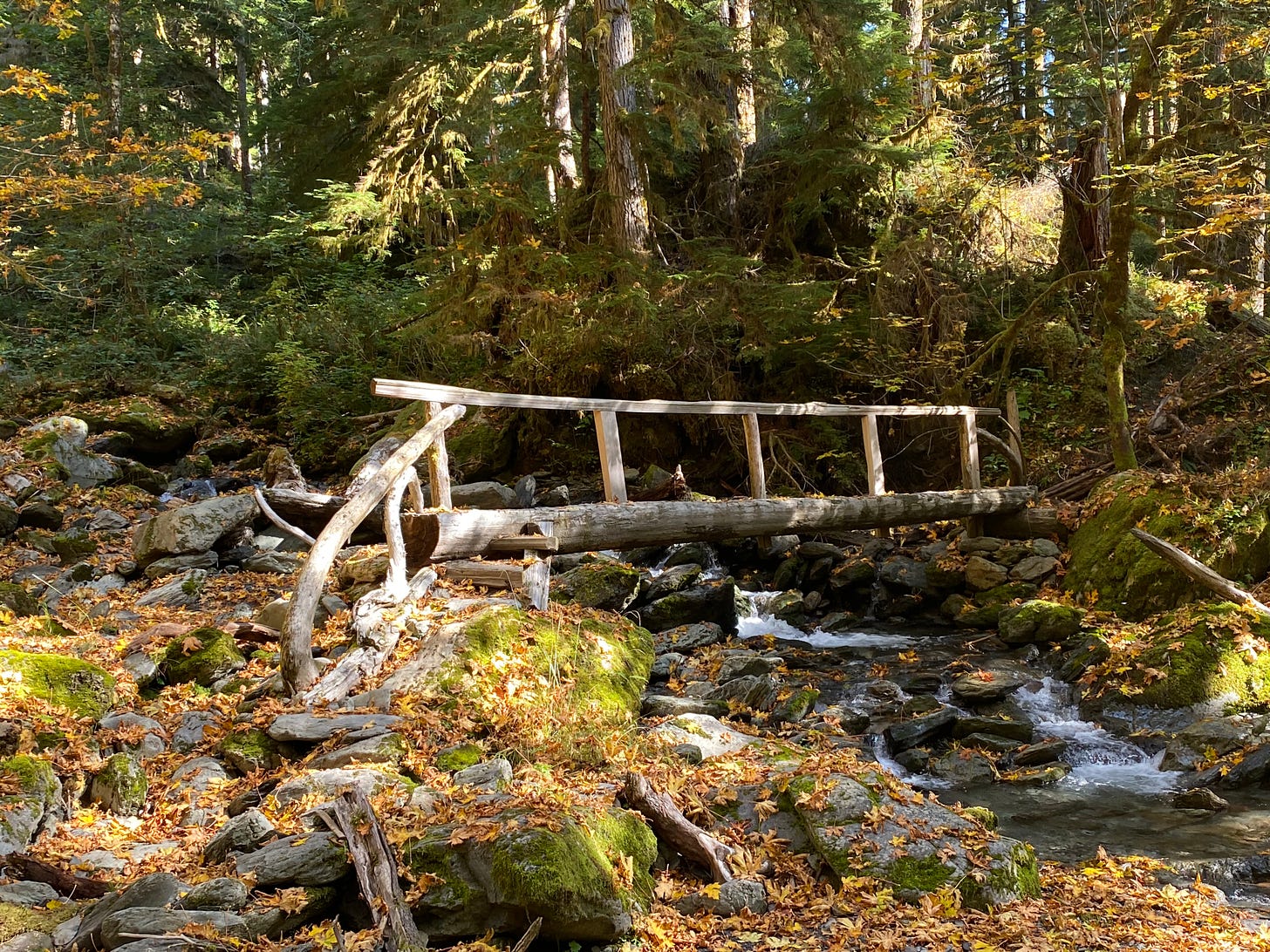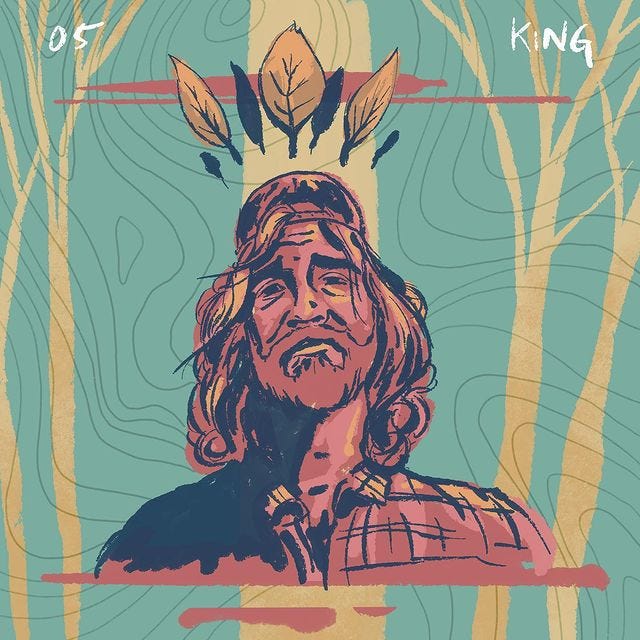I Could Preach The Green Brown Woods To All The Juiceless World
How do you write about trees that are older than the language you write in?

You may or may not be sick of hearing me talk about the experience of walking in the woods and all the things it means to me. In fact I wrote a whole book about it, and if I couldn’t say it in almost 400 pages there it may not be worth saying.
But hey this is my newsletter, and if you’re reading it maybe you do care. I’ll just have to risk it.
Anyway, I took what is likely my last backpacking trip of the year over the weekend, out to the Enchanted Valley Chalet along the East Fork of the Quinault River. That meant 27 miles of hiking in two days through old growth forest in one of the most quiet, serene places I can imagine. Packing for trips like these is old hat to me after this many years and this many miles, so I was struck by how strange and weighty one very minor decision felt the night before I left: namely, whether or not to bring a pair of headphones.
This isn’t something I normally have to think about because most of the time I’m backpacking with other people and it would be ridiculous to bring them. But a solo trip guaranteed to take me four-plus hours each way plus the whole night in between felt different. I realized I was getting almost panicky thinking about the prospect of simply existing in my own head for that much time, with nothing to do but walk, no distractions available. And of course it was that same realization of panic that made the decision for me: there was no way I could bring them along. If nothing else, I needed to prove to myself that my brain isn’t so polluted that it can’t bear the thought of two days without someone else’s voice or someone else’s music to break up the time. When I go to the woods, it is to clear my head, not fill it; to sweep out the detritus and be reminded again what it is to be a person who is inextricable from the world around him. It’s very hard to do that when you’re leaning on stimulation as a crutch.

I hope this doesn’t sound preachy. I certainly can’t prescribe my logic or methods to anyone else; “your mileage may vary” is often true figuratively but when it comes to hiking it is true literally as well.
Two years ago I hiked this same trail in late September. On that occasion I ran into almost no one, and during the rare hours that it wasn’t raining, a chill fog made its presence felt. Pretty ideal conditions for an old-growth forest where everything is quieter than you realize and the moss catches the moisture out of the air and you can trick yourself into believing that you are walking through a door into a different time. I camped completely alone that weekend, not another person in miles, and when a bull elk wandered near my tent and started bugling I almost died of fright before coming to my senses and appreciating the gift. It’s just about the loneliest sound in the world.
This time was different—the sun shone all weekend, replacing the wet and heavy primeval vibes with the lights and colors of autumn, and there were lots of other people out on trail. I had nothing in my head but the smells and sounds of the forest and the frequent thought of food. (Despite being old hat at packing I had left my lunch in the fridge and had to subsist on snacks out there instead. Backpacking is more often than not an exercise in making the most of things.)

When I walk I have a compulsion to touch the trees I go past. There is not any one particular reason for this from what I can tell, but I do it all the same. Big trees feel safe, warm, alive in a way I have trouble putting words to; if I can say anything definitive about the ancient cedars and firs and pines the blanket the Olympic Peninsula, it’s that they make me feel hopeful. Hopeful that things can live so long, not just enduring, but thriving. Western redcedar trees have been known to reach 1,500 years of age. How many times in the last 1.5 millennia have people thought things were as bad as they could ever be, that the world was ending? I walked past countless blowdowns carved up by chainsaws to keep the trail free, and in their cross sections there were too many rings to count. Trees older than any notion of “America” are commonplace—juveniles, really—out in that ancient quiet place. Nothing like that math to make you feel a little more humble.
Which is not to say that our current problems aren’t worth thinking about. On the contrary—if nothing else, these jaunts to the woods make it painfully clear to me just how connected we all are. Giant cedars and redwoods and sequoias can survive the most devastating of fires, but even they have no defenses against rapid changes in climate or drastic changes to their ecosystems. And our concern for the trees doesn’t have to be purely altruistic, either: in their trunks is kept knowledge about our own past, and as a result, about our future, too. Take the bristlecone pine:
Empires rose and fell; wars raged; people were enslaved and freed; and the tree from 2500 B.C. continued its implacable slow-motion existence, adding about two-hundredths of an inch to the diameter of its trunk each year. Minute changes in the tree-ring record make bristlecones an exceptionally useful source of data about changing conditions on earth. When rains are heavier than normal, the rings widen. When volcanic eruptions cause global cooling, frost rings make the anomaly visible. The precision of these records means that bristlecones have periodically butted into other disciplines: geology, archeology, climatology. In the nineteen-sixties and seventies, the trees contributed to the upending of the canonical theory that Bronze Age civilization had spread westward from Egypt and the Near East. Bristlecones have also affected modern political discourse: the famous “hockey stick graph,” which two decades ago raised awareness of human-driven global warming, relied on bristlecone data.

Speaking of the past, and the notion that our present state of turmoil is unique in its crises: Jon Mooalem wrote in 2017 in The New York Times Magazine about the era when Sequoia National Park was established in California,
a moment in America not so wildly different from our own. It was an era of intensifying inequality, vulnerability and dislocation. Urban industrialization upended rural tradition, and populist uprisings, like the Pullman Strike and the Haymarket Riot, pitted an exasperated working class against a government that seemed to collude with the corporations exploiting it. As a labor leader in San Francisco named James Martin wrote, with society seemingly in “chaotic condition, there is ample scope for the most dismal speculation.”
(I also learned from this story that the famous General Sherman Tree, the world’s largest by volume, was originally named The Karl Marx Tree, a moniker given by the utopian socialists trying to create a life for themselves among the sequoias. My life as a socialist and my life as an outdoorsman continue to collide in strange and interesting ways.)
So I try to remain hopeful even as I feel the urgency of trying to mitigate, to end, the imiseration of the world. Something I am moved by each time I walk through old forests is the preponderance of nurse logs and stumps—those peculiar dead trees that are growing whole new trees out of their own wreckage. A tree falls or is cut down; on the rich surfaces of its once-living body new life is permitted to sprout and grow tall. In the redwoods I have seen forest giants whose base is rooted in the stump or side of another, fed by the litter of the rains and floods and animals, fed by the heavy mosses that are pulled like blankets over the dead. Their sacrifices make more fertile the ground for the next generation of giants. We might all learn something from them.

Take care of yourselves out there. I’ll talk to you next week.
-Chuck
PS- If you liked what you read here, why not subscribe and get this newsletter in your inbox each week? It’s free and always will be.
PPS- My friend Brian drew this picture of me in all my outdoor glory as part of Inktober. Check out his work & give him a follow, imo.




